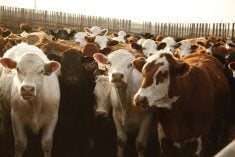AIRDRIE, Alta. – There are more than 300,000 horses in Alberta and each one drops about 15 kilograms of manure plus a few litres of urine a day.
Before long, the horse lover is staring at a manure pile that has become a breeding ground for insects, parasites and water contamination.
“Even with a little bit of snow melt, that water is taking nutrients with your horse manure to a water body,” Christine Sweet of Alberta Agriculture told a horse manure seminar in Airdrie.
“It is your responsibility to manage that manure pile.”
Read Also

Growth plates are instrumental in shaping a horse’s life
Young horse training plans and workloads must match their skeletal development. Failing to plan around growth plates can create lifelong physical problems.
Alberta Agriculture has strict regulations for handling livestock manure, which are enforced through the natural resources conservation board. It deals with complaints and if there is a serious problem, officials provide suggestions or levy penalties. If the problem is serious, Alberta Environment could step in.
Manure should be piled on a clay base to absorb leaks or on a cement pad with a lip to keep water from seeping out. It must be stored at least 30 metres away from surface and ground water. It should not be stored in low-lying areas or close to buildings.
Horse manure can be composted but must be watered to keep the microbes working because it tends to be drier than other types.
Manure with sawdust contains 4.8 kg of nitrogen per tonne, two kg of phosphorus and 2.5 kg of potassium. The nutrient content increases somewhat if straw is used.
Manure mixed with wood shavings composts more slowly than manure mixed with straw or peat.
Composting is better than leaving a manure pile to its own devices, which can take 10 years to decompose.
“Stockpiling manure is not composting,” Sweet said.
“Just because you have it piled up does not mean you have a composting program.”
Rules to spread by
Spreading manure is a good option but the NRCB has specific requirements. For example, it cannot be applied on frozen or snow-covered ground. Horse manure should be spread during warm, dry weather and then harrowed to break up clumps so it dries faster and kills parasites.
Harrowing can be incorporated into a pasture rest rotation plan. After the area has been grazed and the horses moved out, the entire area should be mowed and harrowed to spread manure.
It can be applied on pasture just before the grass goes to seed. Horses should be kept off the pasture for about two weeks to ensure there are no residues left.
“Horses are spot grazers so you get hills and valleys in your pasture,” said horse specialist Les Burwash.
“If they defecated in an area, they won’t graze close to the pile.”
Manure can also be sold to mushroom farms or gardeners looking for composted material for specialty items like rose gardens.
If selling or giving manure away, keep accurate records of where and when it went, as well as the volume sold.















